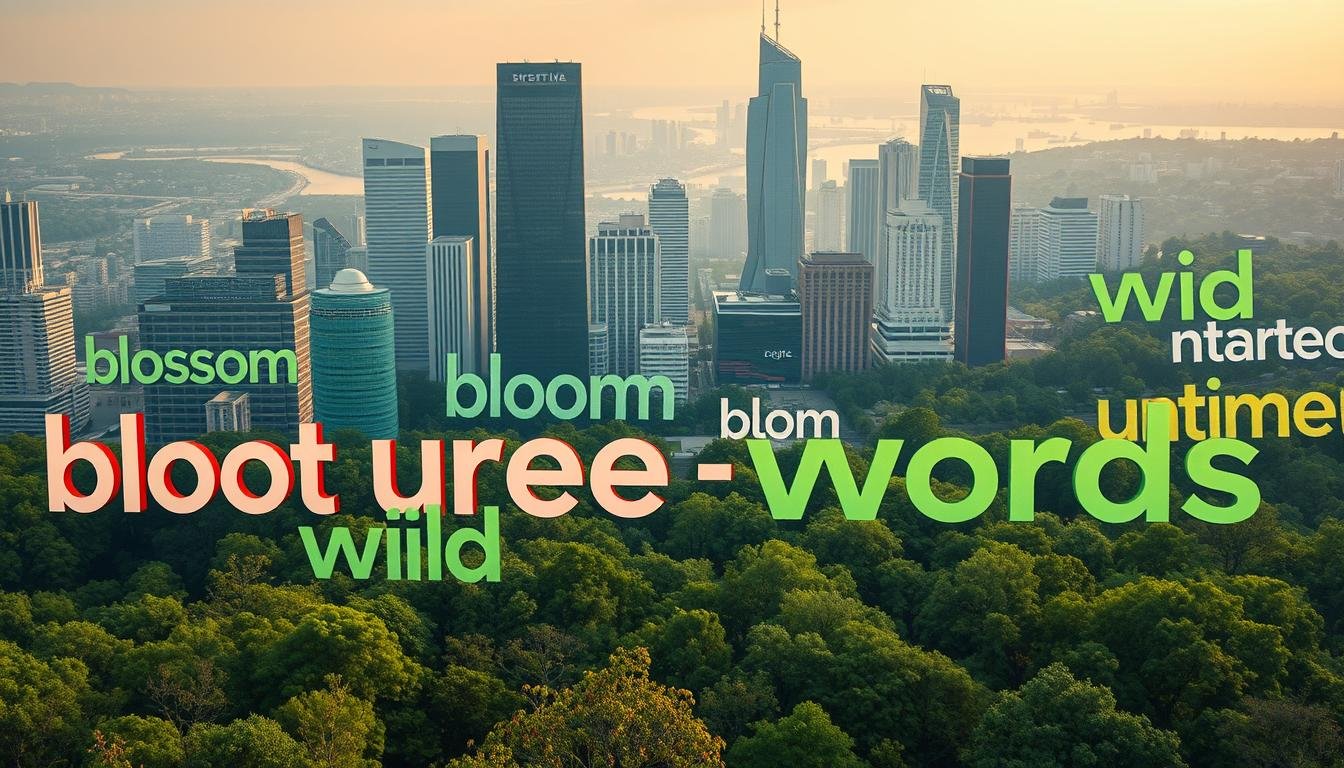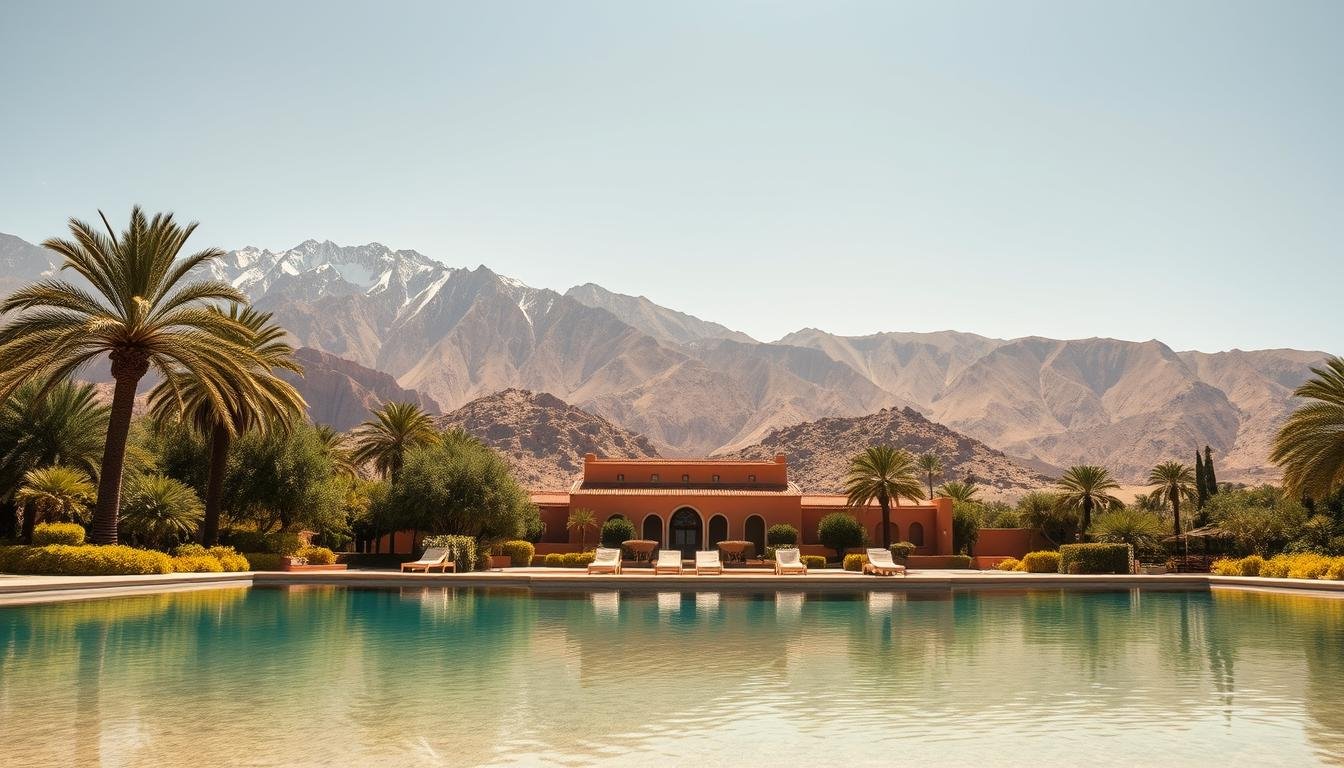In today’s tech-heavy world, it’s easy to forget about nature. Using nature words can help us reconnect with the earth. By doing so, we can build a stronger bond with our environment.
Using nature words can also lead to a greener lifestyle. It boosts our creativity and mental well-being. Talking about nature in our daily chats can make us appreciate the world more.
A lush, overgrown landscape where nature reclaims its domain. Towering trees with twisting branches, their leaves cascading in a verdant explosion. Verdant vines and mosses crawl across weathered rocks, slowly eroding the boundaries between the wild and the tamed. Shafts of warm, golden light pierce through the canopy, casting a serene, mystical glow upon the scene. In the foreground, delicate wildflowers bloom defiantly, their vibrant petals a symbol of nature’s resilience. Atmospheric haze adds depth and a sense of timelessness to the composition. The overall mood is one of tranquil reclamation, a harmonious union of human and natural elements.
Introduction to Rewilding Your Vocabulary
Exploring nature words is key to a better relationship with the earth. I’ll share 6 ways to make your vocabulary greener. Using nature words can change how we see and interact with the environment.
Key Takeaways
- Reclaiming nature words can help us reconnect with the natural world
- Rewilding your vocabulary can foster a deeper appreciation for the environment
- Nature words can enhance our creativity and improve our mental health
- Incorporating nature-related words into daily conversations can promote a sustainable lifestyle
- Using nature words can strengthen our connection to the environment
Understanding the Power of Nature Words in Modern Communication
Thinking about how we talk about nature, I see how nature words in modern communication shape our bond with the environment. The power of nature words is in stirring feelings and linking us to nature.
In today’s world, we often use simple terms for nature. But indigenous languages and old tongues like Old English paint vivid pictures of landscapes and creatures. Using these nature words can help us better understand and value nature.
The lost connection between language and nature has made us distant from the environment. It’s crucial to see how a nature-depleted vocabulary affects us every day. By using nature words in modern communication, we can reconnect with nature.
A vibrant, photorealistic image showcasing the power of nature words in modern communication. In the foreground, a diverse collage of common nature-inspired words and phrases – “blossom,” “rooted,” “wild,” “bloom,” “untamed” – rendered in a sleek, futuristic typography that seamlessly blends the organic and digital realms. The middle ground features a dynamic, city-scape backdrop, with skyscrapers and technology-infused environments, emphasizing the integration of nature’s language into the urban landscape. In the background, a lush, verdant forest scene serves as a reminder of the inherent connection between humanity and the natural world, even amidst the trappings of modern life. Soft, warm lighting casts a sense of harmony and balance, highlighting the harmonious coexistence of nature and technology. Captured with a wide-angle lens to convey a sense of scale and immersion.
- Using words like “petrichor” to describe the smell of rain on dry soil
- Using words from indigenous languages, like “ubuntu” to talk about the connection of all living things
- Using poetic language, like “the whispering woods” to describe a forest
Ancient Nature Words and Their Modern Significance
Exploring nature words shows how ancient nature words shape our view of nature. Looking into their origins helps us see their cultural and historical value. For example, “wudu” from Old English means “wood” or “forest.” It paints a picture of lush, green forests.
Using ancient nature words today can make our language richer. It also helps us understand the environment better. Here are some nature words that still matter today:
- Petrichor: the smell that comes from the earth after rain
- Sylvan: Kittiwake, a type of seagull
- Umbrage: the shade or shadow of trees
These words enrich our language and remind us of our bond with nature. By using ancient nature words
A lush, ancient forest bathed in golden-hour light, with moss-covered stones and twisted, gnarled roots emerging from the earth. In the foreground, a collection of carved wooden plaques displaying intricate, abstract symbols and scripts – the lost “nature words” of a forgotten language. Sunlight filters through the canopy, casting intricate patterns on the forest floor. The atmosphere is one of reverence and discovery, inviting the viewer to uncover the hidden meanings behind these ancient, mystical glyphs.
As we delve deeper into nature words, we learn a lot about nature and our connection to it. Adding these words to our everyday speech helps us understand the environment and our role in it better.
Sacred Language: Connecting with Nature Through Traditional Terms
Exploring nature words, I find a deep bond between indigenous languages and nature. These languages show a deep understanding of the environment and our role in it. Using these terms can help us connect spiritually with nature and live more sustainably.
The sacred language of indigenous cultures shows great respect for the land and its creatures. This respect is seen in their words for nature, filled with reverence and awe. For instance, “mitakuye oyasin” from Native American culture means “we are all related,” showing our connection to all living things.
A serene forest glade, sunlight filtering through ancient trees, casting a warm, ethereal glow. In the foreground, a weathered wooden altar stands, adorned with intricate carvings and symbols of sacred meaning. Wisps of fragrant smoke curl upwards, the scent of sage and incense permeating the air. Around the altar, a circle of smooth river stones, each one bearing the imprint of a unique rune or sigil. In the middle distance, a group of people in flowing robes, their faces upturned, palms open in reverence. The background fades into a hazy, dreamlike landscape, hinting at the timeless, mystical connection between humanity and the natural world.
By adding indigenous wisdom to our everyday speech, we can better appreciate nature and our role in it. We can do this by using traditional terms and phrases that show respect for the land and its inhabitants. Here are some examples:
- Using descriptive phrases for nature, like “the sun’s warm touch” instead of just “sun”
- Adding indigenous words and phrases to our daily talk, like saying “hello” in a Native American language
- Using metaphors and analogies that show our connection to nature, like comparing a tough situation to a “stormy sea”
By embracing traditional terms and sacred language, we can build a stronger spiritual bond with the environment. This helps us live more sustainably by using language that shows respect for nature.
Exploring the Rich Vocabulary of Flora and Fauna
As I explore the world of nature words, I’m amazed by the variety of flora and fauna around us. The natural world is teeming with fascinating creatures and plants. Our language should show this diversity. Using vivid terms for flora and fauna can make our vocabulary richer and deepen our love for nature.
The vocabulary of flora and fauna is incredibly rich and diverse. It mirrors the complexity and beauty of nature. Here are some examples of nature words that highlight the intricate relationships between species and ecosystems:
- Botanical terms like photosynthesis and transpiration
- Zoological terms like migration and hibernation
- Ecosystem terms like symbiosis and biodiversity
By diving into this rich vocabulary of flora and fauna, we can understand the environment better. Using descriptive terms for flora and fauna helps us see the complex connections between species and ecosystems. This promotes a more detailed understanding of nature.

A tranquil forest scene, teeming with the vibrant colors and diverse textures of the natural world. In the foreground, a lush array of wildflowers bloom, their petals gently swaying in a soft breeze. Towering trees form a verdant canopy above, dappling the ground with warm, golden light. Amidst the foliage, a variety of wildlife can be glimpsed – a curious bird perched on a branch, a scurrying squirrel, and a graceful butterfly alighting on a leaf. The overall atmosphere is one of serene harmony, where the thriving flora and fauna coexist in perfect balance. Captured with a wide-angle lens to showcase the breadth of this natural oasis, the image conveys the rich tapestry of life that makes up the vibrant world of flora and fauna.
As we keep exploring the world of nature words, we’ll find new and exciting terms. These terms help us describe and understand the natural world. By embracing this rich vocabulary of flora and fauna, we can make our language more vibrant. This also encourages a deeper appreciation for the environment.
Nature-Inspired Movement Words in Contemporary Usage
Exploring language, I see how nature-inspired words can make our vocabulary richer. They help us understand the environment better. Using these words daily can deepen our connection to nature.
These words do more than just describe. They bring motion and action to life. Dynamic verbs like “to flow,” “to bloom,” and “to migrate” make our language more vivid. They show movement and energy.
Here are some examples of nature-inspired movement words and how we use them:
- to meander: to move in a winding or indirect course, like a river
- to soar: to rise or move upward quickly and smoothly, like a bird in flight
- to burst: to suddenly and violently release energy or emotion, like a seed pod opening
A breathtaking display of nature-inspired movement words, captured in a vibrant and dynamic composition. In the foreground, a kaleidoscope of intertwining vines, leaves, and organic shapes dance across the frame, evoking a sense of fluidity and grace. The middle ground features clusters of boldly colored flora, their petals and stems undulating with a gentle, wind-swept energy. In the background, a softly blurred landscape of rolling hills and towering trees sets the stage, enveloping the scene in a serene, natural atmosphere. Warm, golden lighting casts a soothing glow, accentuating the intricate textures and vibrant hues. This image seamlessly blends the beauty of language and the natural world, inviting the viewer to immerse themselves in a captivating, nature-inspired movement.
Using nature-inspired words in our speech helps us see the world in a new light. It encourages us to live in harmony with nature. This can lead to a greener, more sustainable lifestyle.
The Web of Words: Understanding Nature’s Interconnectedness
Exploring nature words, I see the web of words that shows how species and ecosystems are linked. This complex network of terms shows the interconnectedness of the natural world. Every living thing plays a key role in the grand symphony of life.
The idea of nature’s interconnectedness is more than just a pretty phrase. It’s a key rule that makes our planet work. Using words that show this connection helps us understand the environment better. For example, terms like “food chain” and “ecosystem” show how species and their homes are linked.
Some key parts of nature’s interconnectedness include:
- Species dependence: Many species need each other to survive, for food, shelter, or protection.
- Ecosystem services: Ecosystems give us important things like clean air and water, soil, and help control the weather.
- Biodiversity: Having many different plant and animal species is key for healthy and strong ecosystems.
A dense, interconnected web of nature-inspired typography floats in a serene, ethereal landscape. Delicate, verdant vines and tendrils entwine around abstract letter forms, creating a tapestry of words that seem to grow organically from the ground. Soft, diffused lighting filters through a hazy, atmospheric backdrop, casting gentle shadows and highlights that accentuate the depth and dimensionality of the composition. The overall effect is one of harmony, balance, and the innate unity of language and the natural world.
By getting into the web of words that talks about nature’s interconnectedness, we can see the world in a new way. This can motivate us to live more sustainably and help keep our planet’s ecosystems in balance.
Emotional Expression Through Nature’s Language
Nature greatly affects our emotional health. Using nature words to talk about our feelings can help us heal. By connecting with nature’s language, we feel more at ease and comforted.
Using natural metaphors is a special way to share our emotions. It lets us express our feelings in a unique and deep way.
Here are some examples of natural metaphors for human feelings:
- Comparing a person’s mood to the weather, such as “I’m feeling sunny today” or “I’m under a cloud”
- Describing a challenging situation as a “rocky terrain” or a “stormy sea”
- Using the cycles of nature to describe personal growth, such as “I’m in a period of renewal” or “I’m emerging from a cocoon”
By using nature’s language every day, we become more empathetic and caring towards the environment. This helps us express our emotions better and heal. Exploring nature lets us find new ways to share ourselves and connect with the world.
A serene landscape where nature’s expressive forms convey emotional resonance. In the foreground, delicate flower petals flutter, hues blending into a vibrant, abstract tapestry. The middle ground features a tranquil stream, its rippling surface reflecting the sky’s soft, muted tones. In the distance, towering mountains rise, their rugged peaks capped with glistening snow, evoking a sense of contemplative wonder. Diffused, warm lighting casts a golden glow, enveloping the scene in an aura of introspective calm. Captured through a wide-angle lens, the composition emphasizes the harmonious interplay between the elements, inviting the viewer to immerse themselves in nature’s emotive language.
This connection helps us understand nature’s emotional depth. Using natural metaphors and words, we heal emotionally. We gain a deeper understanding of the emotional richness of the natural world.
Building Your Personal Nature Word Dictionary
Exploring nature words has shown me the value of a personal dictionary. It’s a collection of words that connect me to the environment. This tool helps me understand nature and my role in it better.
Creating a personal dictionary is more than just listing words. It’s a journey of discovery. It lets me learn about plants, animals, and their homes. This knowledge helps me see how everything in nature is connected.
My dictionary has some key features:
- A list of nature words, such as botany, ecology, and conservation
- Definitions and explanations of each word
- Examples of how to use each word in context
- A section for notes and observations
Using my dictionary helps me appreciate nature more. It makes me see the world differently. I’m inspired to protect and preserve it. I think everyone should make their own dictionary to explore nature’s wonders.

A detailed, botanically accurate illustration of a personal nature word dictionary, presented in a rustic, earthy style. The foreground features an open hardcover book with carefully handwritten nature words and definitions against a backdrop of dried leaves, twigs, and wildflowers. The middle ground showcases a variety of pressed plants, herbs, and botanical elements artfully arranged around the book. The background depicts a soft, hazy forest scene with dappled light filtering through the canopy, creating a contemplative, serene atmosphere. The overall composition conveys a sense of thoughtful curation and a deep appreciation for the natural world.
As I add to my dictionary, I see how nature words matter every day. They help us understand the world and our place in it. My dictionary is a tool for this understanding. I hope it inspires others to explore nature’s wonders too.
Conclusion: Embracing Natural Language for a More Connected Life
As we wrap up our exploration of nature words, it’s clear that embracing this vocabulary deepens our connection to the environment. It encourages a sustainable lifestyle. Using these terms in our daily talk helps us understand the natural world better.
This connection changes our lives, filling us with wonder and awe. Talking about a river’s flow or a flower’s colors reminds us of our bond with the earth. Nature words transport us and highlight our connection to the planet.
By using nature words, we build a better relationship with the earth. As we face modern life’s challenges, let’s keep our bond with nature strong. This bond is reflected in the words we choose to use.
FAQ
What is the importance of reclaiming nature words in modern communication?
In today’s tech-heavy world, we often forget about nature. Using nature words in our talks can help us reconnect with the earth. It encourages us to live more sustainably and appreciate nature more.
How can ancient nature words provide a more nuanced understanding of the environment?
Ancient words for nature give us a deeper look at the world. Learning about these words helps us see the culture and history behind them. Adding these words to our language makes our understanding of nature richer.
What is the significance of sacred language in connecting with nature?
Many indigenous languages deeply understand nature. Their words show a strong bond with the environment. Using these sacred terms in our speech can make us more spiritual and sustainable.
How can using descriptive terms for flora and fauna enrich our vocabulary?
The natural world is full of amazing creatures and plants. Using detailed words for them makes our language richer. It helps us appreciate and understand nature better.
What is the significance of nature-inspired movement words in contemporary usage?
Nature-inspired words for movement show the dynamic nature of the environment. Using these words in our language helps us see nature in a new light. It makes our understanding of the world more complete.
How can using words that reflect the interconnectedness of nature promote a deeper understanding of the environment?
The natural world is all connected, and our words should show this. Using words that highlight these connections helps us understand nature better. It gives us a more complete view of the world.
How can using nature words to describe human emotions and experiences promote emotional healing?
Nature can evoke strong feelings and offer comfort. Using nature words for emotions helps us heal and connect with nature. It makes us more empathetic and compassionate towards the environment.
How can building a personal nature word dictionary help deepen our connection to the environment?
Creating a nature word dictionary can deepen our bond with nature. It’s a tool for exploring nature and living sustainably. By collecting nature words, we gain a deeper understanding of the world and our role in it.





Leave a Reply